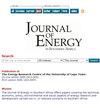在南非应用的低成本反射板热能吸收系统的开发
IF 0.6
4区 工程技术
Q4 ENERGY & FUELS
引用次数: 0
摘要
采用创新的设计技术和自适应技术,以低成本材料为原料开发了一种新型太阳能集热器系统。系统设计需要放置长黑色聚合物管串联循环连接,安装并定位在倒箱肋镀锌钢板槽中。凹槽将入射光线反射并聚焦在中心管道上,将入射太阳光线集中在黑色管道上,增加了循环水管道对热能的吸收。水的循环是由一个小型光伏板供电的直流电太阳能驱动泵促进的。收集的热能储存在一个标准的家用间歇泉水箱中。这种类型的一个3 × 4米的吸热器每天收集大约10千瓦时的能量。考虑到该产品预期10年生命周期内的资本支出,该系统的估计成本估计为每千瓦时0.25兰特。这一价格与南非中等家庭的一般电网电费(每月每千瓦时2兰特至1000千瓦时,包括税收)相比,竞争极为有利。据估计,电力成本每年上涨5%以上,使用这种原型机的家庭十年可节省约20万兰特。通过研究开发的技术和设计可以通过制造、安装、维修和维护系统,在南非的城市和农村环境中创造许多新的商业机会。本文章由计算机程序翻译,如有差异,请以英文原文为准。
Development of low-cost reflective plate thermal energy absorber systems for application in South Africa
An innovative solar heat collector system was developed from low-cost materials by applying innovative design technology and using adaptive technologies. The system design entails placing long black polymer pipes connected in series circulation, mounted and positioned in grooves of inverted box rib galvanised steel plating. The grooves reflect and focus the incident rays on the centre piping, concentrating incident sun rays on the black piping and increasing the absorption of thermal energy in the piping filled with circulating water. The circulation of the water is facilitated by a direct-current solar-driven pump powered by a small photovoltaic panel. The thermal energy as collected is stored in a standard household geyser tank. A 3 × 4 m heat absorber of this type collects approximately 10 kWh of energy per day. The estimated cost of the system, considering the capital outlay over an expected ten-year life cycle for the product was estimated at R0.25 per kWh. This pricing competes extremely favourably with the general cost of grid electricity in South Africa for medium-sized households, which is of the order of R2 per kWh up to 1000 kWh per month, including taxes. With an estimated electricity cost escalation of above 5% every year, the ten-year saving for a household using this prototype can be approximately R200 000. The technology and designs developed through the study can create many new business opportunities in South Africa in both urban and rural environments, through manufacturing, installing, repairing, and maintaining the systems.
求助全文
通过发布文献求助,成功后即可免费获取论文全文。
去求助
来源期刊

Journal of Energy in Southern Africa
ENERGY & FUELS-
CiteScore
3.00
自引率
0.00%
发文量
16
审稿时长
6 months
期刊介绍:
The journal has a regional focus on southern Africa. Manuscripts that are accepted for consideration to publish in the journal must address energy issues in southern Africa or have a clear component relevant to southern Africa, including research that was set-up or designed in the region. The southern African region is considered to be constituted by the following fifteen (15) countries: Angola, Botswana, Democratic Republic of Congo, Lesotho, Malawi, Madagascar, Mauritius, Mozambique, Namibia, Seychelles, South Africa, Swaziland, Tanzania, Zambia and Zimbabwe.
Within this broad field of energy research, topics of particular interest include energy efficiency, modelling, renewable energy, poverty, sustainable development, climate change mitigation, energy security, energy policy, energy governance, markets, technology and innovation.
 求助内容:
求助内容: 应助结果提醒方式:
应助结果提醒方式:


